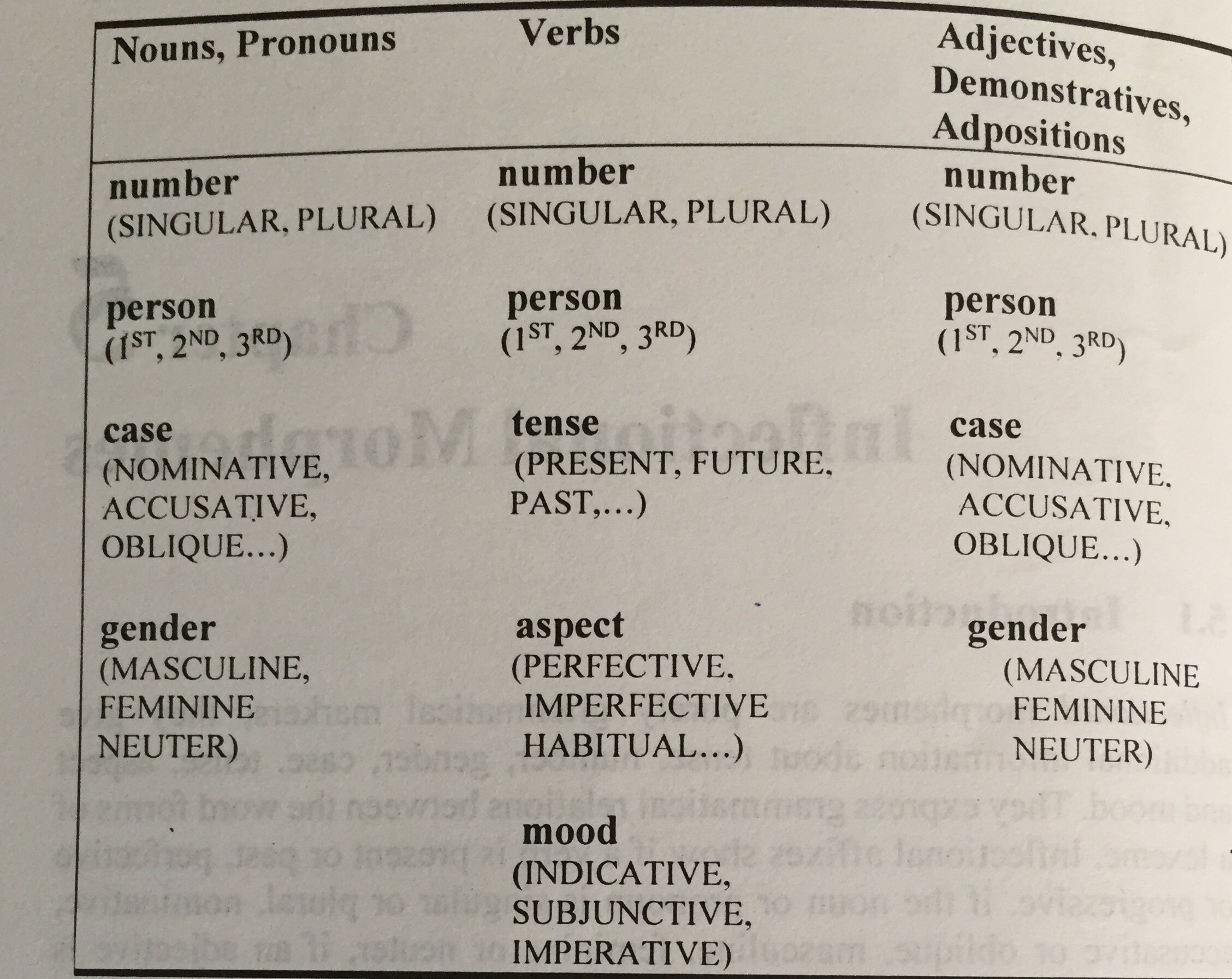Bolanle Elizabeth Arokoyo
Morphology Lecture Series XII
1. Inflectional Morphemes
We are gradually coming to the end of our discussion on the The Morpheme and it’s functions. The previous lecture was on Derivation of Adjectives and Adverbs. Get yourself acquainted with the lectures, please.
Our lecture today is on inflectional morphology. We will examine inflectional morphemes and morphosyntax.
Inflectional morphemes are purely grammatical markers; they give additional information about tense, number, gender, case, tense, aspect andmood.
They express grammatical relationsbetween the word forms of a lexeme.
Inflectional affixes show if a verb is present or past, perfective or progressive, if the noun or pronoun is singular or plural, nominative, accusative or oblique, masculine, feminine or neuter, if an adjective is comparative or superlative.
Since they are not derivational, they do not change the class of the word they are attached to nor the meaning.
They are usually attached to complete words and they close grammatical forms.
Both lexical and functional morphemes are open to inflections.
Different languages code inflection differently.
The languages that are classified as inflectional/ fusional exhibit a very rich inflectional base compared to languages that are classified as agglutinating and isolating at the end of the spectrum.
Due to the nature of inflectional languages, some of the affixes cannot be segmented to actually see how the different case features are bundled.
Despite the fact that not all languages code all inflections but the inflectional types cut across languages.
We can see from Table 1 the classes of inflections and the recipients.

Table 1: Classes of Inflections and the Recipients
From the table above, we can deduce that inflections are grouped together into values.
The grammatical information in the table above when affixed to the recipients do change their forms.
As indicated in the table above, each word class has inflectional affixes that are unique to it.
For example the feature person is distinguished into 1st, 2nd or 3rd person and it is a feature of the noun and the pronoun, the verbalso has to agree with the feature.
Another inherent inflection for nouns and verbs are number, gender, noun class, definiteness and case.
Inflection features for verbs include tense, aspect, mood and voice.
The verb in most cases has to agree with the features of its arguments especially the external argument.
Adjectives are inflected for degrees of comparison which is either comparative or superlative while there are also agreement features for the adjectives too.
In Hausa, for example, the adjective is inflected for plural if the head of the Noun Phrase (NP) that it is modifying is plural.
Determiners, demonstratives, pronouns, and adjectives are also marked for gender and any of them modifying a noun must also agree with the gender feature of the noun being modified. Consider the following French data.
1.
a. la fille la fille blanche
fem. fem. fem. fem. fem.
‘the girl‘ ‘the white girl’
b. le livre. le livre blanc
masc. masc. masc. masc. masc.
‘the book’ ‘the white book’
2.
a. une fille une fille blanche
fem. fem. fem. fem. fem.
‘a girl’ ‘a white girl’
b. un livre un livre blanc
masc. masc. masc. masc. masc.
‘a book’ ‘a white book’
When a noun begins with a vowel, the article used is l’ followed by the word.
In cases like that, the gender status of the word might have to be learnt.
However, for nouns that have either masculine or feminine status, the ending will show whether the word is masculine or feminine, the feminine always end with –e.
3. Feminine Masculine
a. l’étudiante l’étudiant ‘student’
b. la voleuse le voleur ‘thief‘
c. la chercheuse le chercheur ‘scientist’
The basic fact of agreement which inflectional morphemes embody is that the inflectional value of the head of a phrase or sentence must agree with the inflectional values of the constituents.
This is saying that the head and its constituents must agree in inflectional features.
Consider the following examples from Gunnin, an Australian language taken from Tallerman (2009, p. 59).
4.
a. benyjin bi-yangga
man GENDER goes
‘The man is walking.’
b. leewa gadi a-yangga
dog run GENDER-goes
‘The dog is running.’
The verbs in the examples agree with the gender feature on the subjects.
The gender for human noun and animate noun in the language is different.
Inflection is relevant to syntax. It shows the grammatical function or meaning expressed by a morphological pattern in syntactic agreement or government (Haspelmath and Sims, 2010, p. 91).
Agreement refers to the marking of morphosyntactic properties of the head on the dependents.
Whatever heads a phrase determines the agreement. The noun determines the agreement properties of its dependent like the determiners, demonstratives and attributive Adjectives.
The verb may also have to agree in number, person and gender with the noun in either subject position or object position.
The preposition may also agree with the object noun phrase in person number and gender.
This shows that there is an intrinsic relationship among the members of a clause.
There is an interface between the grammatical information provided by the inflectional morphemes and the syntax.
Inflectional morphology provides the need for the morphological and syntactic interface hence, morphosyntax.
2. Morphosyntax
Morphosyntax studies grammatical units that have both morphological and syntactic properties.
It is the set of rules that govern grammatical units whose features are definable by both morphological and syntactic criteria.
These grammatical units are definable using both morphology and syntax as they apply to words.
Grammatical categories like NUMBER, CASE, GENDER, PERSON, TENSE, ASPECT, etc. are morphosyntactic.
Number contrast for example is morphosyntactic in most languages.
Number contrasts require a morphological marking with an affix, for example the suffix –s in English and it also affects syntax because of the agreement between the subject and the verb.
There are languages, for example Hausa, where the adjective must also agree with the noun it is modifying.
Exercises
1. Examine how gender is marked in at leastthree languages. Provide examples in each language.
2. Describe how case is marked in at least three languages. Show the case declension in the language. Provide examples in each language.
3. Conduct some research in five languages of your choice where tense is morphologically marked. How is tense marked in those languages? Provide sufficient examples. Contrast tense marking the languages.
4. Some languages distinguish number as singular and plural, others distinguish as singular and non-singular. Discuss how number is indicated in the two broad categories.
5. Describe inflectional affixes.
NB
a. In the next lecture, we will examine Noun Class System.
b Excerpts are taken from Arokoyo (2017).
References
Arokoyo, Bolanle Elizabeth. (2017). Unlocking morphology. Ilorin: Chridamel Publishing House.
Haspelmath, Martins and Andrew Sims (2010). Understanding morphology. London: Hodder Education.
Tallerman, Maggie. (2009). Understanding syntax. London: Hodder Arnold.

YOU NEED QUALITY VISITORS THAT BUY FROM YOU ?I can get for your site visitors:- from search engines – visitors from social media – visitors from any country you want – very low bounce rate & long visit durationCLAIM YOUR 24 HOURS FREE TEST => https://bit.ly/3gqLEoEDo not forget to read Review to convince you, is already being tested by many people who have trusted it !!
Everyone loves it whenever people get together and share views. Great website, stick with it!
Thank you for stopping by.
YOU NEED HELP FOR SEO LINK BUILDING?
We offer you the BEST SEO STRATEGY for 2020, my name is Winfred Lofton, and I’m a SEO Specialist.
I just checked out your website bolanlearokoyo.com, and wanted to find out if you need help for SEO Link Building ?
Build unlimited number of Backlinks and increase Traffic to your websites which will lead to a higher number of customers and much more sales for you.
SEE FOR YOURSELF=> https://bit.ly/3dhrKtA
Thank you. The site is majorly for educational purposes.
YOU NEED QUALITY VISITORS for your: bolanlearokoyo.com
My name is Hellen Northrup, and I’m a Web Traffic Specialist. I can get:
– visitors from search engines
– visitors from social media
– visitors from any country you want
– very low bounce rate & long visit duration
CLAIM YOUR 24 HOURS FREE TEST => https://bit.ly/3h750yC
YOU NEED FAST PROXY SERVERS ?
Check it out this Anonymous and Private Proxy Servers.
HTTP & SOCKS5 Proxy supported.
IP Authentication or Password Authentication available.
HERE: https://bit.ly/Cheap_Proxy_Servers
YOU NEED FAST PROXY SERVERS ?
Check it out this Anonymous and Private Proxy Servers.
HTTP & SOCKS5 Proxy supported.
IP Authentication or Password Authentication available.
HERE: https://bit.ly/3ifZkmL
BEST PROGRAM FOR ADVERTISEMENT!
XRumer is the best program for advertisement!
It’s have CAPTCHA recognizer, email verificator, and a lot of other functions…
This software will help to increase traffic to website to hundreds, thousands times.
Program have a rich seven year history, which use experience of professionals in search engine optimization.
Appreciate and use a truly unique and powerful XRumer program, can both professionals and beginners.
MORE INFO=> https://bit.ly/39RzWR4
BEST PROGRAM FOR ADVERTISEMENT!
XRumer is the best program for advertisement!
It’s have CAPTCHA recognizer, email verificator, and a lot of other functions…
This software will help to increase traffic to website to hundreds, thousands times.
Program have a rich seven year history, which use experience of professionals in search engine optimization.
Appreciate and use a truly unique and powerful XRumer program, can both professionals and beginners.
MORE INFO=> https://bit.ly/39RzWR4